TABLE OF CONTENTS
If you're not familiar with slow cook barbecue, then you won't understand that beef brisket requires several hours and continuous heat to become a mind-blowing taste experience. If you have heard of corned beef, this is essentially salt-cured brisket. It's often reserved for corned beef and cabbage but is not limited to many other savory recipes.
Why is it called corned beef?
Most people these days wouldn't even know where corned beef gets its name unless you had a feisty Irish grandmother who tells you why. As it turns out, back in the old days (around the 5th century), in England and throughout central Europe, nearly everything that needed preserving was placed into the brine. Brine is made from water and salt, and according to the old English description of salt, they used to call it just like it looked.
Salt back then was very coarse and looked just like rough unrefined grain. The surprising part is that anything particle-sized was called grain, so it was used to describe spices, tiny seeds, and granule-sized material. Salt was used to help preserve beef brisket and many other cuts of beaf for long-term preservation. In the old days, salty water could allow the beaf to remain preserved for one week without refrigeration.
On a ship that sailed around the Atlantic, brined beef could last months despite having a horrible stench- it was technically still edible! It needed to be boiled for a while to destroy the bacteria, yet hard-living sailors in the 1700s had cast-iron stomachs like the Vikings. The actual corned beef name is not English but Germanic. Their ancient word used around the 1660s was Kurnam' or kernel- just like a corn kernel.
The old English territories described the size of salt used to make brined water solutions for their corned' beef. But later, it was accepted that grain-sized was perfectly fine to tell the size of salt granules used to make corned beef. It's funny how these preserved foods got their name and haven't changed after more than 360 years!
Preparing the corned beef
The few times that you can get your hand on corned beef will depend on the year when you go shopping. Then again, you can immediately buy corned beef at selected Kosher delicatessens. The most common time to look for fresh corned beef is between the late winter and early spring. You'll see it more often before St. Patrick's Day for sure. The best way is to make corned beef at home using a traditional corned beef brine recipe.
Once you have completed corned beef brisket, all you need to do to prepare it is very simple. All that is required is rinsing the meat under cool and clean water to wash away any excess salt on the meat's surface. The flavor within the meat is what you're ultimately going to enjoy the most. You may likely have overly salty meat if you don't rinse your corned beef.
For the most part, having a pot that slow cooks this meat must have enough water inside. This ensures that anything else inside the pot will also be seasoned with that meaty flavor and spices that helped enhance your corned beef.
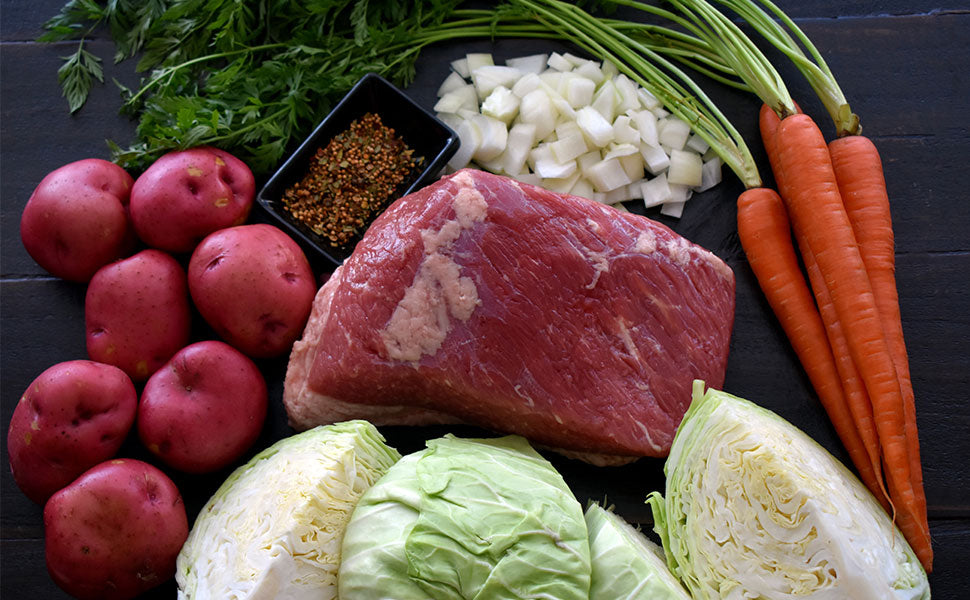
Ingredients needed
As most people will agree, corned beef can include many individual ingredients that make great sides to go along with it. This can consist of potatoes, carrots, cabbage, and added seasonings such as Dijon mustard, olive oil, and beer. These ingredients can go into the same pot that will be slow-cooked to help bring fantastic flavor to your dish. The best additions are typically baby carrots and small potatoes of your choice.
Mustard that is smeared onto your corned beef acts as a binder and is best when you use hearty Dijon mustard that has cracked mustard seeds inside the mixture. Many people like to use a crockpot however a dutch oven is a better solution if you have a larger cut of meat.
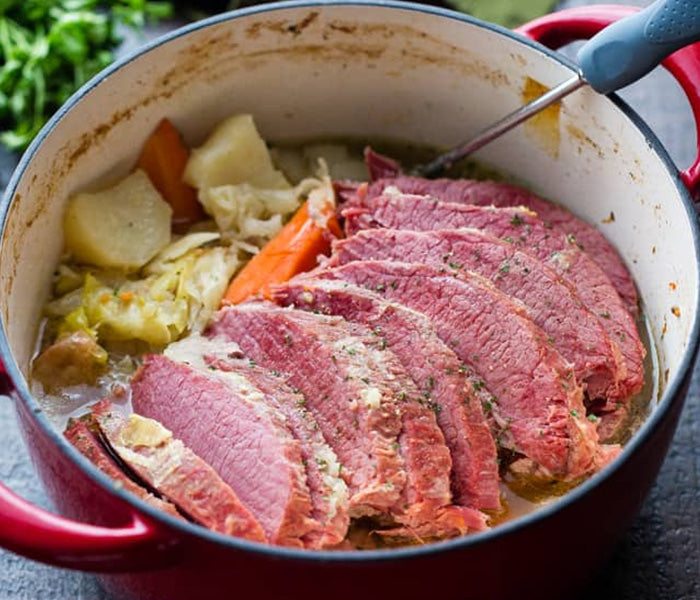
How to make Dutch oven corned beef
The typical metal used to make a Dutch oven is made from cast-iron. These large cooking pots are sometimes coated with a ceramic lining which helps them become non-stick. This is perfect for slow cooking, making soups and stews, and low-temperature applications. Cast-iron is better suited for high temperatures and must be seasoned to protect the interior. Most folks have the Dutch oven without a ceramic coating which is more universal for cooking and baking. Learn more about instructions on dutch oven.
You want to start with all fresh ingredients for your Dutch oven corned beef recipe. Be sure to wash all of your baby potatoes and carrots under cold water to remove any dirt or possible contaminants from them. The cabbage is best when sliced into smaller sections before it's put into the pot. It doesn't need washing aside from peeling off the first couple of layers and then cutting into small sections.
This is done just like you would with cantaloupe or orange slices and makes it easier to put into your pot. It also makes serving corned beef easier when everything is pre-sliced. Place your corned beef into the pot and apply some mustard or olive oil onto the surface and along the sides. Then add your carrots and potatoes followed by the cabbage wedges into the pot.
At this point, you add a liquid into the pot so that the surface of your meat is covered. As it will take time to slow cook this meal, a certain amount of absorption and steam will escape. You'll also need to refill the pot to help your meat not dry out while it cooks. You can use any broth, vegetable stock, beer, or combination.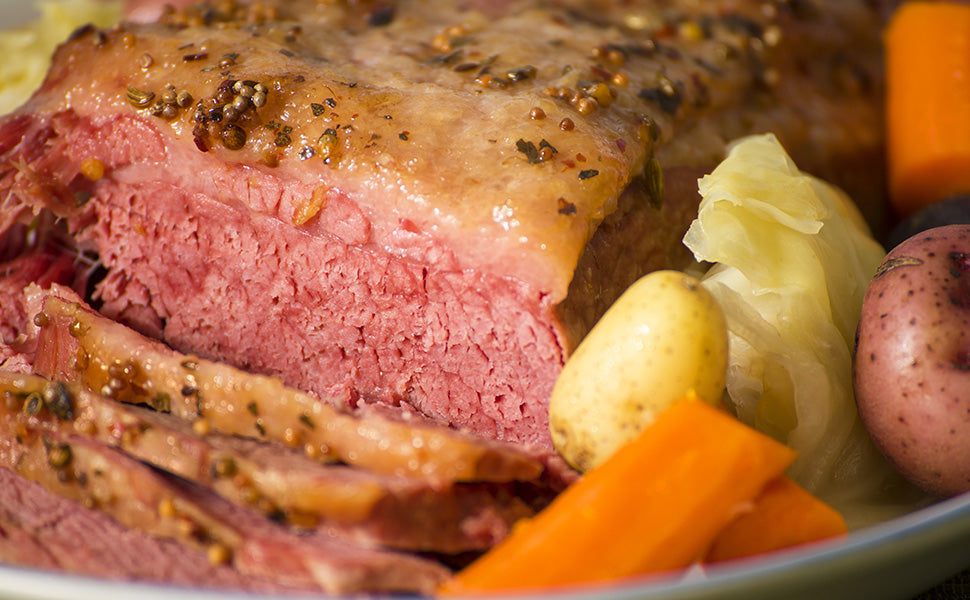
Quick tips for corned beef
Even if you're new to making Dutch oven corned beef for the first time, it's relatively impossible to screw up unless you didn't follow the recipe. Some expert tips will give you better results than most recipes. Adding these tips to your cooking schedule will increase the level of flavor and the presentation of your dish when it's time to serve.
• Choose the right veggies
Look for the best selection of carrots, cabbage, and potatoes. Size doesn't always matter but does have an attractive touch if they are smaller pieces that don't need slicing. That doesn't take away from their flavor, but it is always dangerous to be overcooked. Potatoes can start to fall apart if they're overcooked, especially when they're sliced. Smaller potatoes stay together when they are small and round.
Don't settle for loose cabbage that isn't so fresh, it should be tightly bound and is nice and crispy. Use an excellent sharp chef knife to slice through one half of a medium-sized cabbage head with a Chef knife. Then section each slice into a wedge for the best results.
• Stick to a constant temperature
The very start of making corned beef after adding your liquid will require the initial boil. After this, any brown foam from the beef should be scooped off and removed. The temperature needs to be reduced to a simmer and this is when you add your veggies. This will ensure that your vegetables aren't getting over-cooked and mark precisely when the cooking time begins.
• Select the best liquid for simmering
This dish is all about flavor, so using a good stock will enhance the taste of cabbage and potatoes. Some folks swear by beer's flavor aside from mixing this with beef stock and beer. Regular water doesn't add flavor and can dilute these flavors even when corned beef has loads of flavor. Adding flavored stock is essential to achieving the best taste that makes veggies and your meat pair well together.
• Use pickling spices
If you happen to do any home pickling, you know what pickle spices are. If you don't, you can filter out the remaining apices found in a typical jar of pickles and add these to your pot. Fresh spices are better if they come in a small packet, so only a palm's worth is needed. What this does is meant to add sweet and spicy flavors throughout the meat. If your corned beef isn't using pickle spices, it just adds a punch to the natural flavors.
• Slicing the finished corned beef
This critical step is more for the presentation when your meat is finished. You don't want to slice the meat with the grain, so each slice must be across the grain. This will help make your brisket soft and tender with each bite that anyone can chew. It's best to slice the meat on a large cutting board using a long meat carving knife. If your brisket is smaller, then a regular Chef knife will do the trick just as quickly.
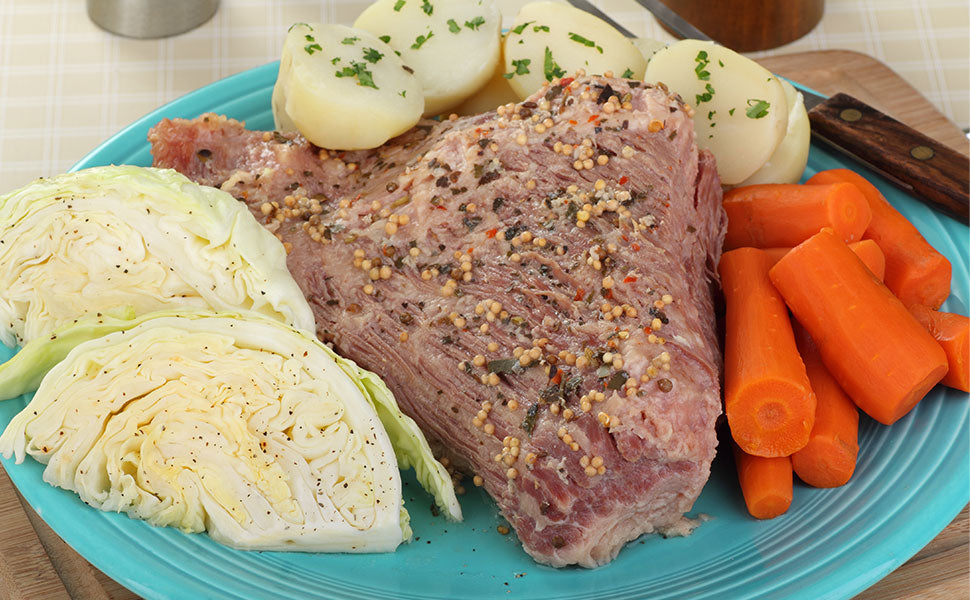
What to serve with corned beef
There is always a good variety of side dishes accompanying corned beef that is perfectly suitable. The first that should be offered is bread or dinner rolls, but not limited to any baked bread made fresh. You might consider side dishes that aren't going to conflict with what is cooked with your corned beef. These can include Saurerkraut, marinated artichoke hearts, or coleslaw.
You might want to add some rye bread and Swiss cheese to make mini Rueben sandwich bites. Add a touch of Dijon mustard onto the corned beef for a final topping. Then again, if you want to see what goes into a Dutch oven recipe, here are all of the ingredients that can be prepared individually or within the same pot. This recipe provides 6 servings and takes only 2 hours and 30 minutes to prepare.
• 1 (3 pounds) Corned beef brisket
• Pickle spice packet
• 10 (small) red potatoes
• 5 medium carrots (or 1Lb. pack of baby carrots)
• 1 (large) head cabbage
• 2 Tbsp Dijon mustard
• Olive oil (optional)
• Stock liquid (Beef/vegetable/beer)
Instructions:
Rinse off your beef brisket in cool water and place this into a Dutch oven. Coat the top and sides with Dijon mustard or olive oil, and add the pickle spices. Now add your stock liquid and fill it, so the meat is covered over the top of the flesh. This is then brought to a boil using high heat.
Once the boil has brought brown foam to the surface, this must be skimmed off and removed. The heat is then reduced to a simmer. Only slight movement of the liquid is needed with an occasional bubble or two coming up. Use the cover to keep the liquid from steaming away.
Alternatively, you should add more liquid for the next two hours.
You now start to prepare your vegetables by washing and scrubbing the potatoes. Remove any dirt or potato eyes. If carrots are whole, cut them into 3-inch strips cut lengthwise into 4 separate pieces. The cabbage needs to be sliced into wedges that look similar to orange slices. Potatoes can be sliced in half if they are larger than a plum.
After the corned beef has simmered for 2 hours, you can add your vegetables so they aren't overcooked. Now you can check the meat to see how tender it is. A fork will stick into the meat easily when it's tender enough. If the meat is ready, remove the whole piece and place it on a wooden cutting board for 5-minutes.
Allow the veggies to cook until you can slide a fork into a potato without using force. This will take between 10 to 15 minutes on average and is enough t6o cook the carrots, potato, and cabbage. The cabbage can be removed sooner or later for some people depending on how soft you like the cabbage to become.
The meat must be sliced against the grain in strips that are no thicker than a pinky fingertip. Strips are placed onto serving plates with some vegetables and a spoonful or two of broth. Serve with selected side dishes that will go with your Dutch oven corned beef meal.
Storing and reheating leftovers
The nice thing about corned beef and cabbage is that the taste improves after a day or two. You'll want to save the liquid used to you and spoon some heated liquid on these leftovers. Store your leftover food in an airtight Tupperware container. Liquid goes best inside any plastic cup container that can also be sealed. Place these in the fridge for no more than 3 days before eating them.
To reheat:
- Don't make the mistake of heating them in the microwave.
- Use a small saucepan and warn this on a stovetop.
- Add the corned beef and veggies first, and then add a small liquid. The heat can be close to simmering but not boiling.
- Allow at least 10 minutes to become reheated fully.
- Place onto a plate and use a little liquid spooned over the top.
FAQs
• Is corned beef hard to cook?
Corned beef is not hard to make if you aren't an expert chef. The hardest part will be finding corned beef sold in your local grocery store, and is often seasonal. With a good recipe for corned beef, it will be elementary to make this meal with little effort.
• How many hours does it take to cook corned beef?
It depends on how much your beef brisket weighs. Larger pieces of brisket need a longer time to simmer and cook while a 3Lb brisket can cook in as little as 2-3 hours. The golden rule allows half an hour per pound to become tender when making corned beef.
• Should brisket be cooked covered or uncovered?
Because corned beef brisket is being simmered inside flavored stock, the liquid will evaporate faster without a lid. It's better to use a lid to avoid refilling the Dutch oven so often.
More article about beef: How to slice beef brisket like a pro?


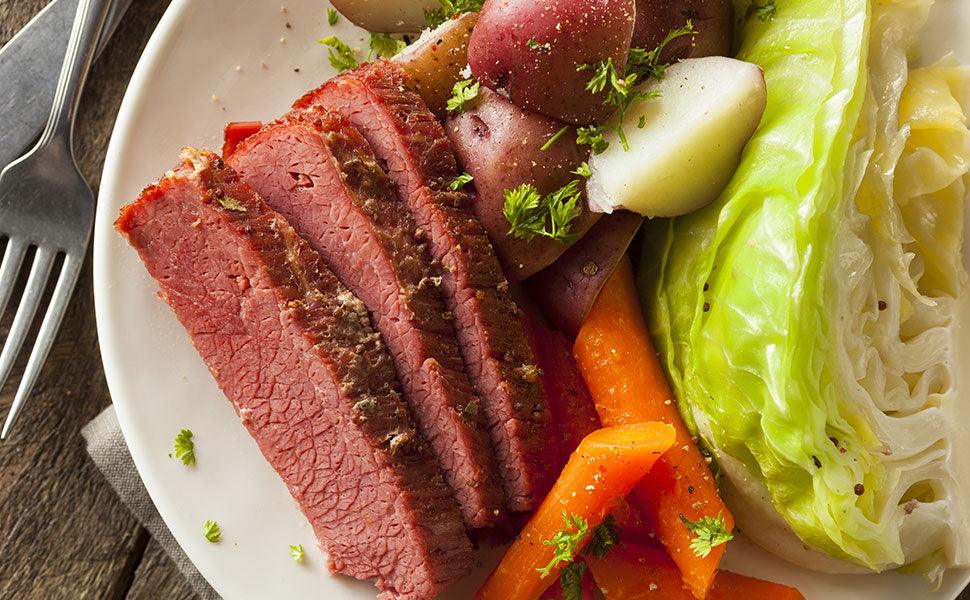
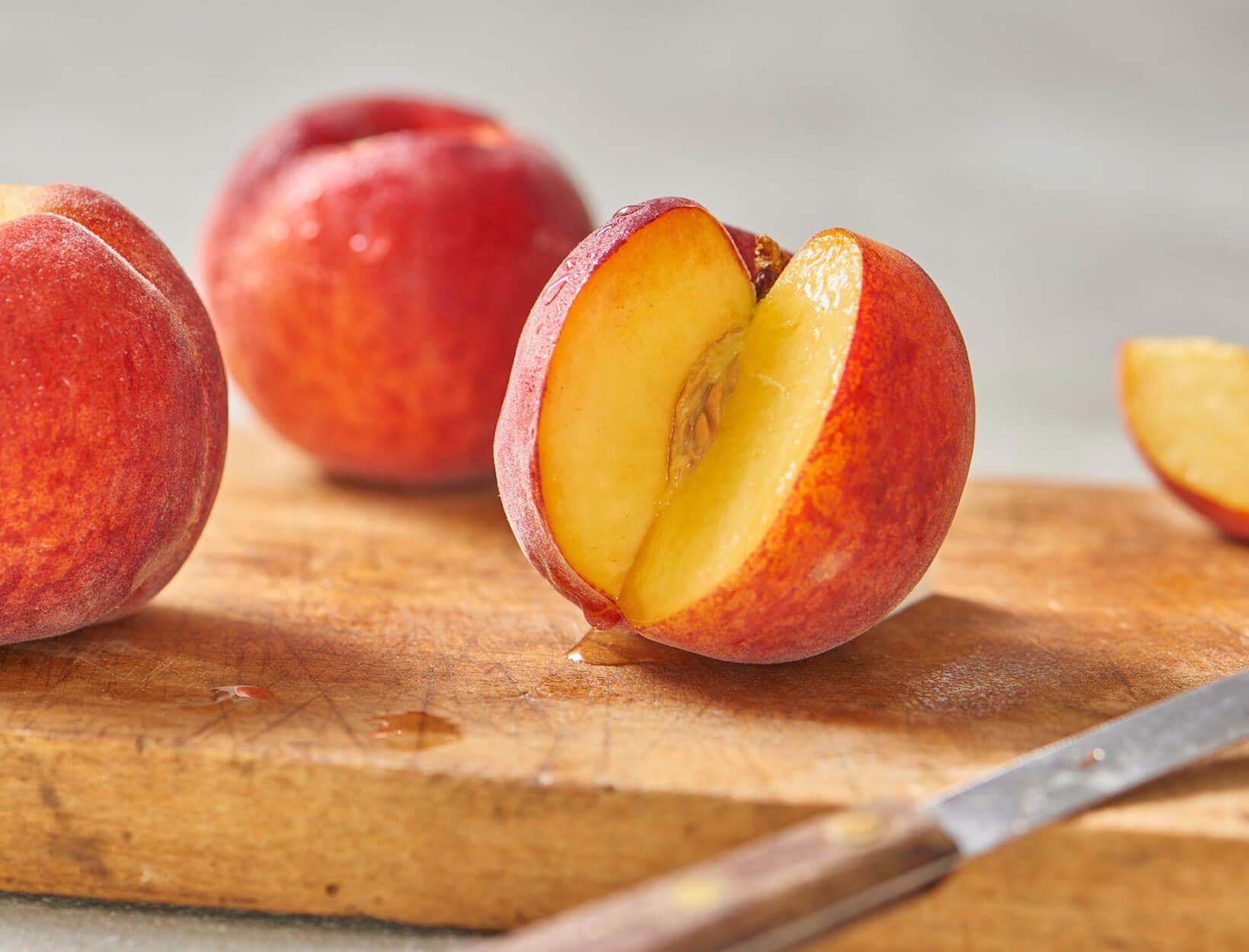
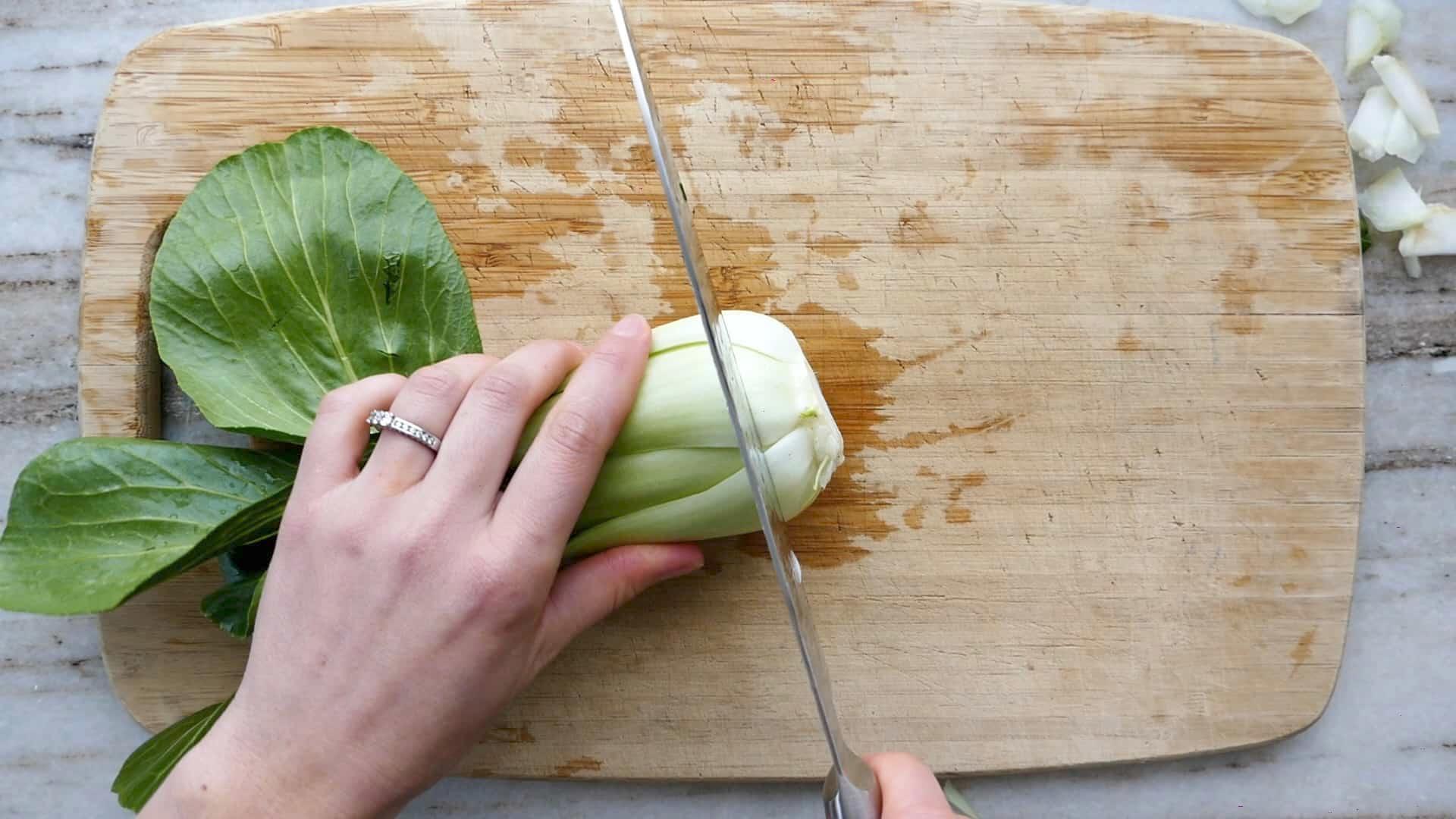

















1 comment
Erin
Great.
Leave a comment
All comments are moderated before being published.
This site is protected by hCaptcha and the hCaptcha Privacy Policy and Terms of Service apply.